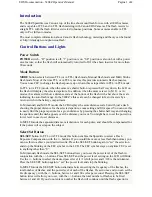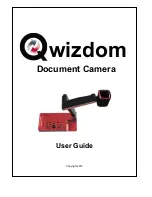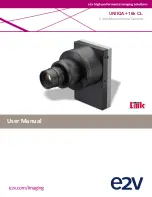
7
Appen
d
ix
128
• Do not clean the camera with organic solvents such as thinner, alcohol,
and benzine.
• Use a lens brush to remove dust accumulated on a lens. Never use a
spray blower for cleaning as it may damage the lens.
• Please contact your nearest service center for professional cleaning of
the CMOS sensor. (This will involve a fee.)
• Periodic inspections are recommended every one to two years to
maintain high performance.
• Do not store the camera with preservatives or chemicals. Storage in high
temperatures and high humidity can cause mold to grow on the camera.
Remove the camera from its case and store it in a dry and well-ventilated
place.
• Avoid using or storing the camera where it may be exposed to static
electricity or electrical interference.
• Avoid using or storing the camera in direct sunlight or in locations where
it may be exposed to rapid changes in temperature or to condensation.
• The SD Memory Card is
equipped with a write-protect
switch. Setting the switch to
LOCK prevents new data from
being recorded on the card, the
stored data from being deleted,
and the card from being
formatted by the camera or
computer.
• The SD Memory Card may be
hot when removing the card immediately after using the camera.
• Do not remove the SD Memory Card or turn off the power while the card
is being accessed. This may cause the data to be lost or the card to be
damaged.
• Do not bend the SD Memory Card or subject it to violent impact. Keep it
away from water and store away from high temperatures.
• Do not remove the SD Memory Card while formatting. The card may be
damaged and become unusable.
• Data on the SD Memory Card may be deleted in the following
circumstances. We do not accept any liability for data that is deleted if
1. the SD Memory Card is mishandled by the user.
2. the SD Memory Card is exposed to static electricity or electrical
interference.
3. the SD Memory Card has not been used for a long time.
4. the SD Memory Card or the battery is removed while the card is being
accessed.
• If the SD Memory Card is not used for a long time, the data on the card
may become unreadable. Be sure to regularly make a backup of
important data on a computer.
• Format new SD Memory Cards. Also format SD Memory Cards
previously used with other cameras.
• Please note that deleting data stored on an SD Memory Card, or
formatting an SD Memory Card does not completely erase the original
data. Deleted data can sometimes be recovered using commercially
available software. If you are going to discard, give away or sell your SD
Memory Card, you should ensure that the data on the card is completely
deleted or the card itself is destroyed if it contains any personal or
sensitive information.
• The data on your SD Memory Card should be managed at your own risk.
• Do not use the camera in a place where electrical products, AV/OA
devices, and so on generate magnetic fields and electromagnetic
waves.
• If the camera is affected by magnetic fields and electromagnetic waves,
it may not be able to communicate.
• If the camera is used near a TV or a radio, poor reception or TV screen
glitch may occur.
• If there are multiple wireless LAN access points near the camera and the
same channel is used, search operation may not be executed correctly.
• The security of your data stored, sent or received is your own
responsibility.
Cleaning Your Camera
Storing Your Camera
About SD Memory Cards
Write-protect
switch
About the Wireless LAN Function
In the frequency band used by the camera, along with industrial,
scientific, and medical devices such as microwave ovens, premises
radio stations (wireless stations requiring license) and specified low
power radio stations (wireless stations not requiring license) for
mobile object identification used in factory production lines, etc., and
amateur radio stations (wireless stations requiring license) are
operated.
1. Before using the camera, confirm that premises radio stations
and specified low power radio stations for mobile object
identification and amateur radio stations are not operated in the
vicinity.
2. In the event that the camera causes harmful radio wave
interference to premises radio stations for mobile object
identification, immediately change the frequency being used to
avoid interference.
3. If you have other troubles such that the camera causes harmful
radio wave interference to specified low power radio stations for
mobile object identification or to amateur radio stations, contact
your nearest service center.
Summary of Contents for K-1
Page 99: ...5 Sharing 97 Device Information Language 4 Change the settings and tap 1 ...
Page 137: ...Memo ...
Page 138: ...Memo ...











































